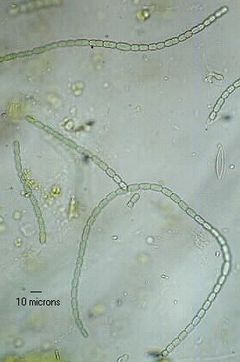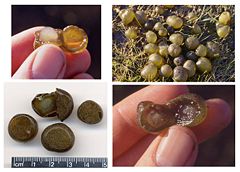- Nostoc
-
Nostoc 
Photo of N. azollae Scientific classification Kingdom: Bacteria Phylum: Cyanobacteria Class: see taxonomic note Order: Nostocales Family: Nostocaceae Genus: Nostoc Species N. azollae
N. caeruleum
N. carneum
N. comminutum
N. commune
N. ellipsosporum
N. flagelliforme
N. linckia
N. longstaffi
N. microscopicum
N. muscorum
N. paludosum
N. pruniforme
N. punctiforme
N. sphaericum
N. sphaeroides
N. spongiaeforme
N. verrucosumNostoc is a genus of cyanobacteria found in a variety of environmental niches that forms colonies composed of filaments of moniliform cells in a gelatinous sheath.
The name "Nostoc" was invented by Paracelsus. [1] It derives from the ancient greek word "nόsos" (νόσος, "disease" or "sickness").
Nostoc can be found in soil, on moist rocks, at the bottom of lakes and springs (both fresh- and saltwater), and rarely in marine habitats. It may also grow symbiotically within the tissues of plants, such as the evolutionarily ancient (Gunnera) or hornworts, providing nitrogen to its host through the action of terminally differentiated cells known as heterocysts. These bacteria contain photosynthetic pigments in their cytoplasm to perform photosynthesis.
Contents
Species
Nostoc is a member of the family Nostocaceae of the order Hormogonales. Species include:
- N. azollae
- N. caeruleum
- N. carneum
- N. comminutum
- N. commune, Koxianmi (Chinese)[2]
- N. ellipsosporum
- N. flagelliforme
- N. linckia
- N. longstaffi
- N. microscopicum
- N. muscorum
- N. paludosum
- N. pruniforme
- N. punctiforme
- N. sphaericum
- N. sphaeroides
- N. spongiaeforme
- N. verrucosum
Non-scientific nomenclature
When on the ground, a Nostoc colony is ordinarily not seen; but after a rain it swells up into a conspicuous jellylike mass, which was once thought to have fallen from the sky, hence the popular names, fallen star, star jelly, Sternschnuppen (shooting stars), troll’s butter and witch’s jelly. It is also called witches' butter (not to be confused with the fungus Tremella mesenterica). Michael Quinion of the World Wide Words newsletter says that it is known in Welsh as pwdre sêr, or rot of the stars.[3]
Culinary use
Containing protein and vitamin C,[citation needed] Nostoc species are cultivated and consumed as a foodstuff, primarily in Asia. The N. flagelliforme and N. commune varieties are consumed in China, Japan and Java, N. commune is also consumed in the Andes. The preferred variety in Central Asia is N. ellipsosporum.
A research team from the biochemistry department of the Chinese University of Hong Kong said that international research has shown that fat choy (Nostoc flagelliforme), besides having no nutritional value, has also been found to contain Beta-methylamino L-alanine (BMAA), a toxic amino acid that could affect the normal functions of nerve cells. Professor Chan King-ming of the team told the media that eating fat choy could lead to degenerative diseases such as Alzheimer's, Parkinson's, and dementia.[4]
References
- ^ Potts M. (1997). "Etymology of the Genus Name Nostoc (Cyanobacteria)". International Journal of Systematic Bacteriology 47 (2): 484. http://ijs.sgmjournals.org/content/47/2/584.full.pdf.
- ^ Abbott, Isabella A (1989). Lembi, Carole A.; Waaland, J. Robert. eds. Algae and human affairs. Cambridge University Press, Phycological Society of America. pp. 141. ISBN 9780521321150.
- ^ Weird Words: Nostoc on World Wide Words
- ^ The standard.com.hk
- http://www.microscopyu.com/galleries/confocal/nostoc.html
- http://www.yourdictionary.com/ahd/n/n0171000.html
- http://www.glerl.noaa.gov/seagrant/GLWL/Algae/Cyanophyta/Cyanophyta.html
- http://machaut.uchicago.edu/cgi-bin/WEBSTER.sh?WORD=nostoc 1913 Webster's Dictionary
- Davidson, Alan. Oxford Companion to Food (1999), "Nostoc". ISBN 0-19-211579-0
External links
Guiry, M.D.; Guiry, G.M. (2008). "Nostoc". AlgaeBase. World-wide electronic publication, National University of Ireland, Galway. http://www.algaebase.org/search/genus/detail/?genus_id=42976.
Categories:- Cyanobacteria
- Bacteria stubs
Wikimedia Foundation. 2010.

